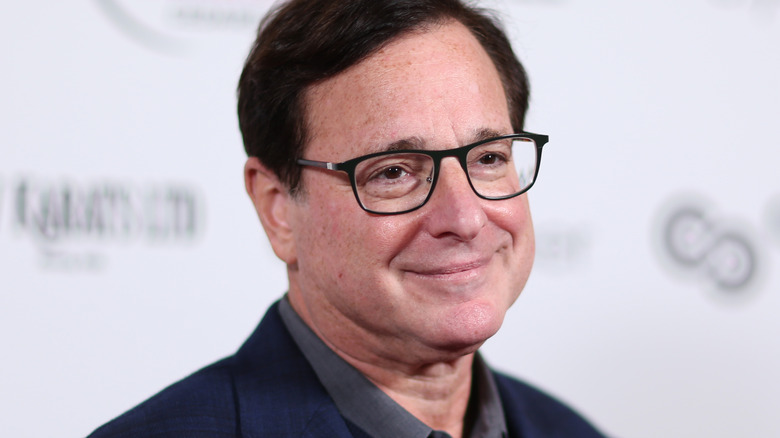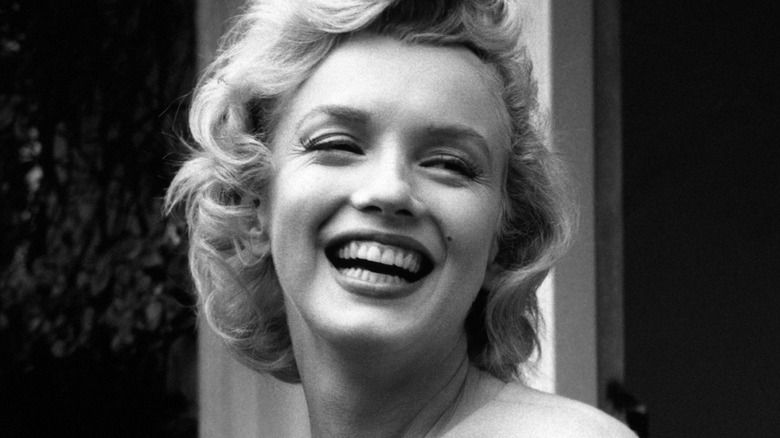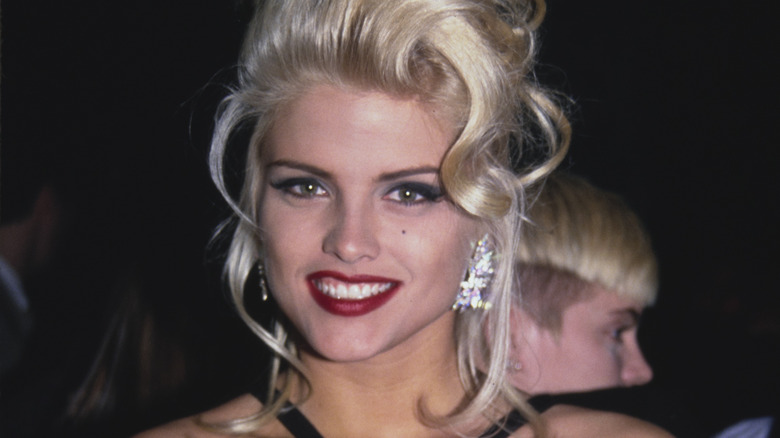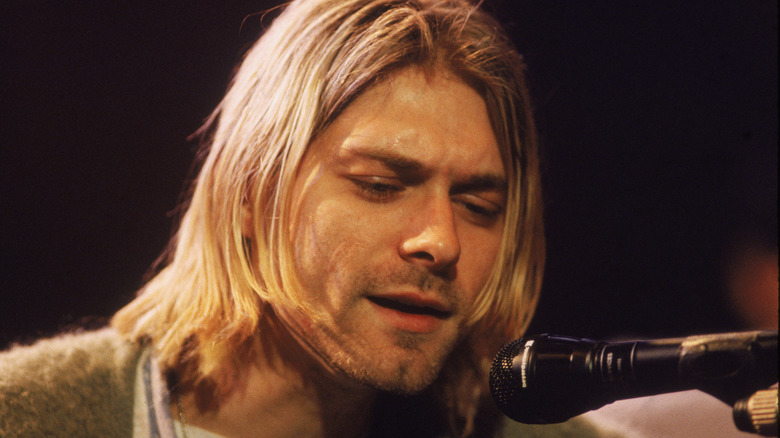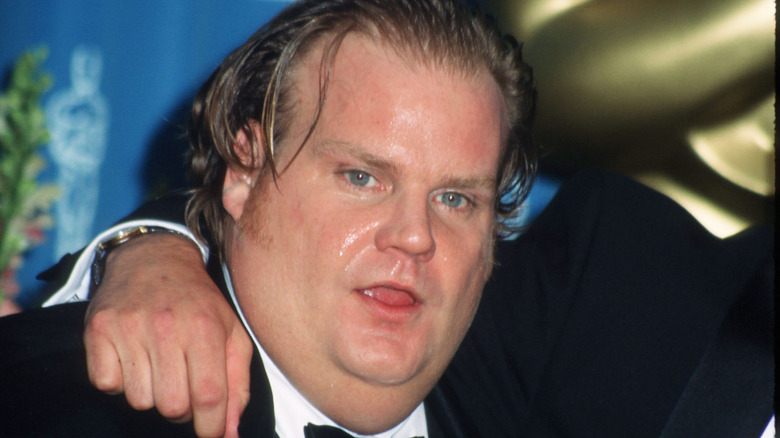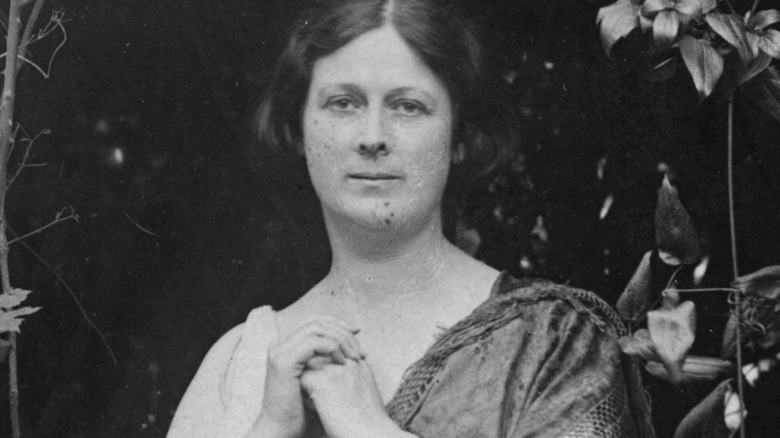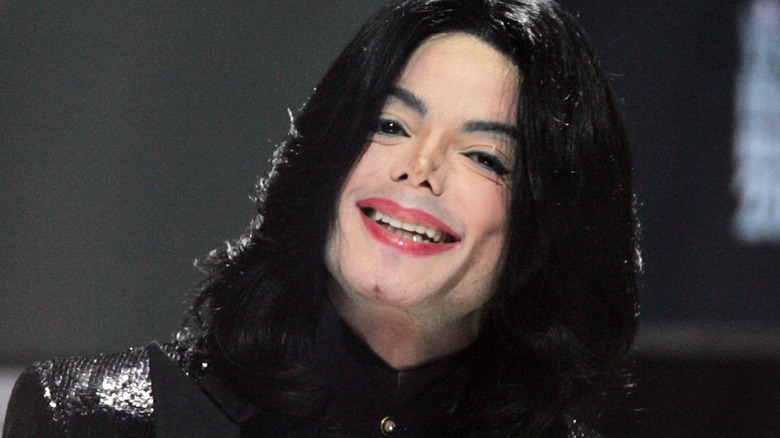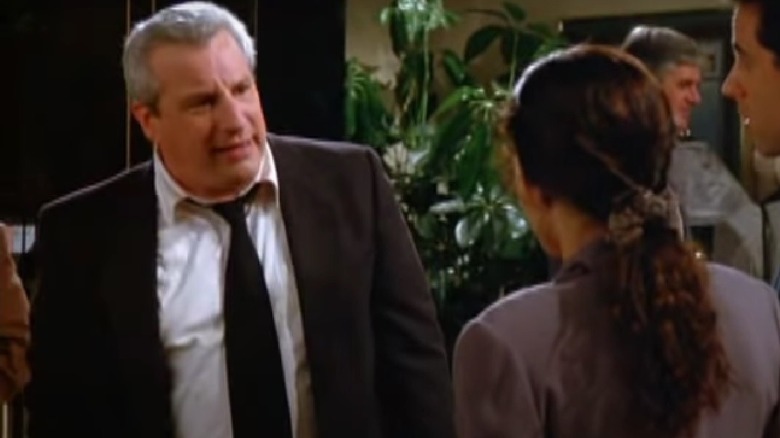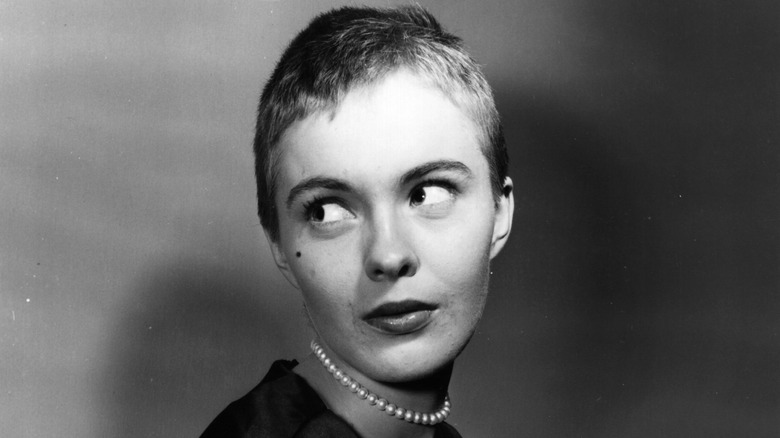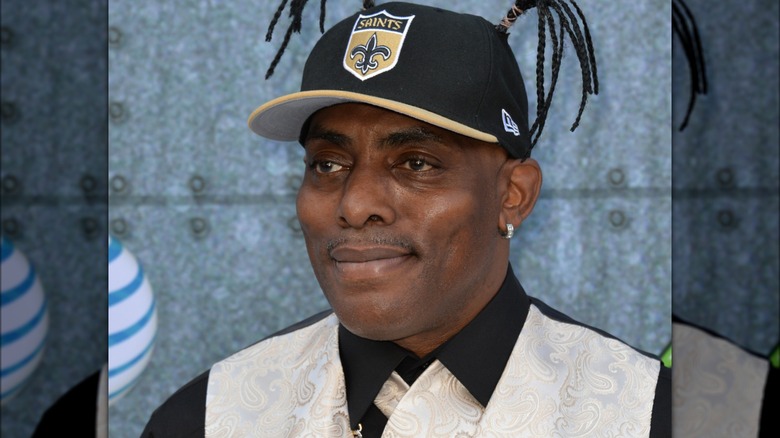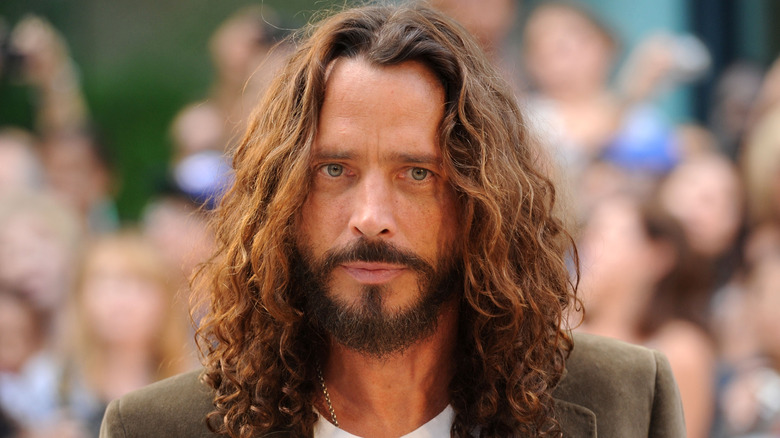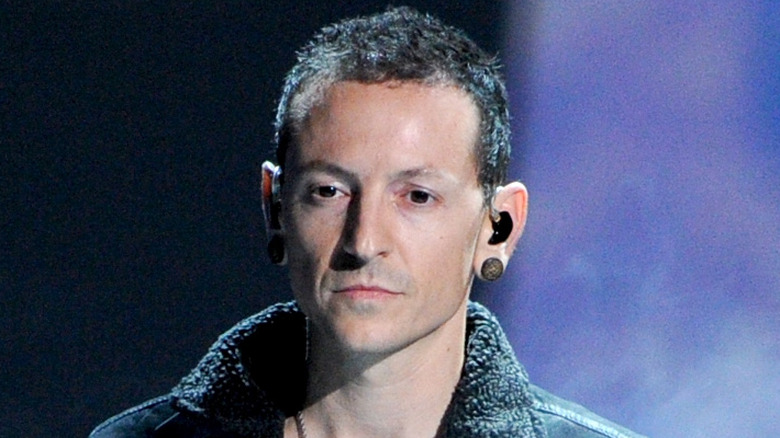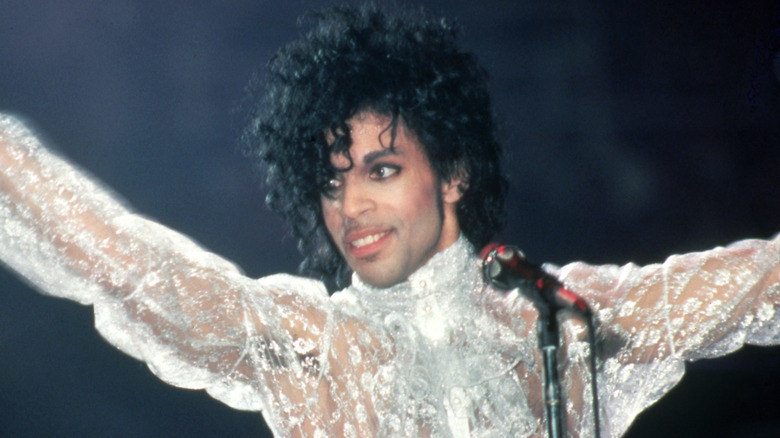Things Found At Celebrity Death Scenes
The following article contains references to substance misuse, mental health struggles, suicide, violence, and eating disorders.
The widespread availability of celebrity death scene photos may seem like a symptom of the technological age, but in reality, the celeb death scene predates the advent of the internet. Since the Golden Age of Hollywood, the public's thirst for access to the private lives of the rich and famous has extended to uncovering information about their deaths. As such, there has been a morbid fascination with witnessing the aftermath of a celebrity's demise. Print media, for instance, published photos of Buddy Holly's death scene following his fatal plane crash in 1959. Now, with social media and technological ease of access to information, the dissemination of celebrity death scene photos is more prevalent than ever.
A death scene can take many forms. Iconic actor Lupe Vélez, for instance, was intent on having a beautiful final moment, reportedly getting glammed up and dressing in her silk fineries before dying, per AnOther magazine. Of course, Vélez's story is the exception to the rule, and the majority of posthumous settings are far from pretty. In many cases, a death scene can end up offering more questions than answers, as an A-lister leaves behind a variety of mysterious mementos, either incidental or suggestive of an uncanny message from beyond the grave. In other cases, however, a seemingly innocuous scene of death can quickly become subject to sinister speculation. From gory trinkets to ghostly toys, let's take a deep — and oh so dark — dive into things found at celebrity death scenes.
Aaron Carter
For many Millennials, Aaron Carter was their first crush. A precursor of sorts to Justin Bieber with his nonthreatening good looks and boyish charm, Carter made a name for himself in the aughts with hits such as "I Want Candy," making tweens the world over swoon. Sadly, Carter would go on to struggle with addiction, and his relationship with his family became increasingly fraught. He once told VladTV his parents apparently swindled him out of millions; in recent years, he attempted to make extra cash through Only Fans.
Sadly, Carter's personal issues only continued through 2022. In September, he lost custody of his infant son, but was in the midst of fighting to get him back, as he revealed to The Sun. He also denied that he was struggling with substance misuse. Weeks later, Carter would be dead.
In November 2022, the rapper was found unresponsive by his housekeeper; he was in the bath, seemingly having drowned, per TMZ. He was 34. Carter's death scene offered more questions than answers. A later TMZ report revealed that the singer was found with cans of compressed air and bottles of prescription medications by the tub. Chillingly, it seems Carter knew he wouldn't lead a long life; an unearthed Us Weekly interview from 2017 presents the singer sharing that he thought he'd be dead before he reached 30.
If you or anyone you know needs help with addiction issues, help is available. Visit the Substance Abuse and Mental Health Services Administration website or contact SAMHSA's National Helpline at 1-800-662-HELP (4357).
Amy Winehouse
Before Adele, there was Amy Winehouse, the soulful songstress whose refreshingly down to earth, unpretentious personality charmed the public. Like so many women in the spotlight, Winehouse frequently generated headlines for her personal life as opposed to her innumerable talents. Of particular media interest was her substance misuse and eating disorder, which became tabloid fodder. "She craved normality. The biggest thing that f***ed Amy up was being famous," her best friend, Tyler James, told The Times. Moreover, the singer was mocked relentlessly in the media.
Throughout the aughts, Winehouse was in and out of treatment and faced various legal issues. In June 2011, she canceled her tour due to ongoing personal issues. Just one month later, the singer was found dead in her London apartment. She was 27. Her cause of death was ruled as alcohol poisoning, though her brother insisted to The Guardian that she died from her eating disorder. As the Daily Mail reported, the singer was found dead with a laptop nearby; she had been watching YouTube videos of herself before dying. Winehouse's death scene is symbolic of a past life that was inevitably coming to an end, her glory days so disparate from the person her myriad struggles had led her to become.
If you or anyone you know needs help with addiction issues, help is available. Visit the Substance Abuse and Mental Health Services Administration website or contact SAMHSA's National Helpline at 1-800-662-HELP (4357).
If you need help with an eating disorder, or know someone who is, help is available. Visit the National Eating Disorders Association website or contact NEDA's Live Helpline at 1-800-931-2237. You can also receive 24/7 Crisis Support via text (send NEDA to 741-741).
Whitney Houston
Singing superstar Whitney Houston amassed millions of fans the world over with her feel-good hits, including the iconic "I Wanna Dance With Somebody," and, of course, her cover of "I Will Always Love You." Despite her effervescent exterior, Houston grappled with childhood trauma, as her loved ones told Vanity Fair. For many years, she struggled with substance misuse, and her tumultuous relationship with Bobby Brown did not help matters.
On February 10, 2012, Houston gave her final performance, singing "Jesus Loves Me" at a Grammys party. The once-in-a-generation singer was found dead in a bathtub at the Beverly Hills Hilton the next day, aged 48.
In photos published by the Daily Mail, it was revealed that there was a gravy boat filled with olive oil in the water (Houston apparently used the substance to maintain her famously glowing complexion) and a hairbrush by the tub. Moreover, there were numerous prescription drugs at the scene; Houston reportedly took Xanax before concerts to ease her anxiety, per TMZ. These findings exemplify the tragedy of a woman so committed to being her best self, but likely equally exhausted by the pressures of stardom. Indeed, just a year earlier, she had gotten into an altercation on a flight, which was blamed on the star's relentless exhaustion, per E! News.
If you or anyone you know needs help with addiction issues, help is available. Visit the Substance Abuse and Mental Health Services Administration website or contact SAMHSA's National Helpline at 1-800-662-HELP (4357).
Bob Saget
We lost far too many celebrities in 2022, and Bob Saget was sadly among those who died. The "Full House" patriarch's death was sudden and unexpected. The comedian had performed a set in Florida the night before he died and appeared to be in good health and high spirits, according to audience members who chatted to E! News. "Everything seemed great," one such observer said. "He absolutely rocked the house. And I think he really felt that." Tragically, Saget was found dead in his hotel room on January 9, 2022. It has been determined that he died of a catastrophic brain injury, possibly caused by a fall or accidental knock on the head in the bathroom, per People. The injury likely occurred shortly before Saget went to bed, with the comic falling asleep and never regaining consciousness.
According to a report by People, on the hotel nightstand, there were a few necessities, including a cell phone, a pair of glasses, various toiletries, and bottled water. These items, such ordinary objects of everyday life, are symbolic of the ephemeral nature of existence, proving that we never truly know when the end is near. Just months before his death, Saget addressed his mortality on the podcast "Til This Day with Radio Rahim," remarking, "I guess therapy, having three kids, watching people pass away in the last few years, mortality, all that stuff, has fortunately changed me."
Marilyn Monroe
Much has been made of the untimely death of Marilyn Monroe. The Hollywood icon's demise remains clouded by increasingly outlandish conspiracy theories. Though the 36-year-old's death seems to be a straightforward overdose, her death scene did raise some questions that fuel conspiratorial lines of thinking.
On August 4, 1962, Monroe was found dead in her home. According to Vanity Fair, she was in low spirits in the lead-up to her passing. She called various friends and her psychiatrist in her final hours, and reportedly spoke of an affair with Bobby Kennedy. In a telephone chat with fellow actor Jeanne Carmen, she complained that she'd been receiving calls from an unknown woman regarding her supposed love for Kennedy. "The voice sounded familiar, but she couldn't put a name to it," Carmen recalled, adding that the caller told her to "Leave Bobby alone, you tramp. Leave Bobby alone." Monroe would be dead by the morning.
Tellingly, she was found clutching a telephone receiver in her hand, leading to immense speculation as to whom she was calling in her final moments, per the Mirror. There was also a note by her body, with a telephone number for the White House. A Los Angeles police official claimed that she had called John F. Kennedy before she died. Whether or not it was JFK Monroe called in her dying moments, her death certainly leads to more questions than answers, symbolic of the multifaceted legacy the enigmatic icon leaves behind.
Philip Seymour Hoffman
A versatile performer who was as much at home playing Truman Capote as he was depicting a vile crank caller in "Happiness," Philip Seymour Hoffman always appeared the unassuming type. But behind closed doors, he was enduring personal struggles, as exemplified by his scene of death.
In 2014, the acting world lost another great when Hoffman died suddenly, aged 46. The actor was found dead in his apartment with a needle in his arm, leading to speculation that he may have overdosed, per the New York Post. Investigators also found 70 clear envelopes with drugs inside, and other drug paraphernalia, such as a burnt spoon. Eight years earlier, Hoffman candidly discussed his past substance misuse in an interview with "60 Minutes," stating that he was sober. "I got sober when I was 22 years old. ... You get panicked. ... I was 22 and I got panicked for my life," he said.
The scene of death painted a particularly tragic portrait, one that he shielded from his loved ones. Indeed, those closest to Hoffman thought he was sober. "I saw him last week, and he was clean and sober, his old self," the actor's friend, David Bar Katz, who found his body, told The New York Times. "I really thought this chapter was over." Such admissions make his death scene all the more devastating.
If you or anyone you know needs help with addiction issues, help is available. Visit the Substance Abuse and Mental Health Services Administration website or contact SAMHSA's National Helpline at 1-800-662-HELP (4357).
Anna Nicole Smith
Anna Nicole Smith was always a larger than life character. Having wed 88-year-old oil tycoon J. Howard Marshall when she was 25, she parodied her vicarious persona in the third "Naked Gun" installment and later went on to launch her own reality series. Despite her gregarious demeanor, her life was blighted by tragedy.
For many years, she was embroiled in a bitter estate dispute following the death of Marshall, with the late billionaire's family asserting that Smith did not have a right to his fortune, per Forbes. And following the birth of Smith's daughter in 2006, her 20-year-old son from a previous marriage, Daniel, died of an overdose in her hospital room, per Reuters.
Less than half a year later, she, too, died of an accidental overdose while staying at the Hard Rock Hotel & Casino, as Today reported. She was 39. Per the Mirror, at the scene of her death, investigators found prescription drugs and a duffle bag with $8,000 inside. Questions remain as to why Smith was carrying around so much money in her final days. Her psychiatrist, Khristine Eroshevich, and boyfriend, Howard K. Stern, were both found guilty of supplying her with the fatal cocktail of drugs, per ABC News. However, in 2012, their convictions were mostly overturned in appeals court.
If you or anyone you know needs help with addiction issues, help is available. Visit the Substance Abuse and Mental Health Services Administration website or contact SAMHSA's National Helpline at 1-800-662-HELP (4357).
Princess Diana
The demise of the people's princess remains one of the most shocking celebrity deaths in history. On that fateful day in 1997, Princess Diana and her boyfriend, Dodi Al-Fayed, were both killed in a car crash in Paris while attempting to escape an onslaught of paparazzi photographers, per The Guardian. Their chauffeur, Henri Paul, was also killed.
Lead investigator Martine Monteil analyzed the death scene for clues as to what happened to Lady Di in her final moments, per the documentary "Investigating Diana: Death in Paris" (via the Daily Mail). In doing so, she found something heart-rending. "We saw signs of braking," Monteil explained. "Pieces of red light from another car. On the side of the car were traces of paint. I was obsessed with finding things ... I even found some tiny pearls. They belonged to the Princess." Diana was famed for her love of pearls, so the image of them scattered across the scene, sundered from her neck, is harrowing to say the least. But another, equally devastating, piece of jewelry was found at the scene.
As the Daily Mail reported, she was found wearing a Bulgari ring that Al-Fayed had gifted her just a couple of days earlier. Recalling the moment he was handed the ring following Diana's death, her butler, Paul Burrell, wrote, "I know she was wearing it when she died because there was dry blood among the tiny diamond." The bloodied jewel is, perhaps, the ultimate symbol of a fallen princess.
Kurt Cobain
The death of grunge icon Kurt Cobain has long spawned conspiracy theories, the most notable being that there was foul play involved in the 27-year-old's untimely death. However, Cobain had a long history of mental health issues, and indeed, suicide attempts, having attempted to end his life in Italy just a month before he died, as noted by Rolling Stone. For many years, he also struggled with substance misuse in part to treat an ongoing stomach issue, which is now believed to have been caused by IBS, per Express.
In 1994, Cobain's body was found in the upstairs greenhouse of his Seattle home. His death was ruled a suicide. Following his death, the Seattle Police Department took photos of the crime scene, but the film remained undeveloped for two decades. As per CBS News, in an effort to quell lingering conspiracy theories, the pictures were developed and examined in 2014. As some of the images show, numerous items were found scattered around Cobain's body, including drug paraphernalia, which he kept in an old cigar box. There was also a wallet, a woolly trapper hat, and, conversely, a pair of sunglasses, which he had been known to fashion together.
If you or anyone you know is having suicidal thoughts, please call the National Suicide Prevention Lifeline by dialing 988 or by calling 1-800-273-TALK (8255).
Chris Farley
Chris Farley gained legions of fans in the '80s and '90s as a breakout star of "Saturday Night Live." Along with BFF and future sitcom lead David Spade, he also starred in the comedy movies "Tommy Boy" and "Black Sheep." Unfortunately, Farley struggled for many years with substance misuse and mental illness.
In his final days, Farley roused the concern of his friends, as his behavior grew increasingly erratic, per Entertainment Weekly. Confronted about his notable decline in health, he simply replied, "I want to live fast and die young." He died on December 18, 1997.
On the day he died, Farley had spent the evening with a stripper named Heidi Hauser. Speaking to the tabloid Globe, Hauser claimed that after a night of partying together, Farley passed out on the ground and she snapped a photo of him, which she provided to the tabloid. Hauser told the outlet that he was breathing when she left, though he would be found dead later that day by his brother. The 33-year-old's death was ruled a drug overdose. According to Rolling Stone, investigators found Farley wearing nothing but pajama bottoms, containers of white powder and antidepressants nearby.
If you or anyone you know needs help with addiction issues, help is available. Visit the Substance Abuse and Mental Health Services Administration website or contact SAMHSA's National Helpline at 1-800-662-HELP (4357)
Isadora Duncan
Isadora Duncan was one of the most revered dancers of her generation and has been dubbed the mother of modern dance, per Barbican. Sadly, her life came to a harrowing and untimely end. In 1927, she was giving her new car a spin when she got into a horrific accident; she was killed instantly after being dragged into the road, as per The New York Times.
When investigators arrived at the scene, they made a grisly discovery: Duncan had a long scarf around her neck, which had become trapped in the wheel of the car, strangling her and breaking her neck. Eerily, she had predicted her premature death just one day earlier, declaring, "For the first time I am writing for money; now I am frightened that some quick accident might happen," per the Los Angeles Times.
The history of the scarf found at the death scene makes Duncan's end all the more devastating. Amelia Gray, who wrote the book "Isadora: A Novel," explained to Lenny Letter that Duncan was gifted the garment, described as "crimson red and twice her size," shortly before her demise. On that fateful — and fatal — day, she called out, "Adieu, mes amis. Je vais à la gloire!" ("Goodbye my friends. I'm going to glory!") to a throng of fans who crowded around her, before being killed in front of them. The scarf may be viewed as a representation of Duncan's larger than life persona, its role in her death a tragic irony.
Michael Jackson
The passing of the undisputed King of Pop sent shockwaves across the world. Just weeks away from embarking on a residency at London's o2 Arena in 2009, Michael Jackson looked set to be launching a remarkable comeback to the stage. That would all change, however, when his life was cut short.
In the lead-up to his comeback, Jackson was struggling with severe insomnia. His sleeping difficulties reached their pinnacle when he remained mostly awake for 60 days straight, per CNN. Desperate to finally get a full night's sleep, Jackson reportedly begged his physician, Conrad Murray, to prescribe propofol, a drug commonly used as a general anesthetic as opposed to a sleep aid, per the Los Angeles Times. After taking propofol and benzodiazepines, the King of Pop died on June 25, 2009. Murray was later found guilty of involuntary manslaughter and sentenced to jail time, per CNN.
Per TMZ, Jackson's death scene is at once haunting and bizarre. The singer was found with an IV drip, numerous tubes of Benoquin (a cream commonly used to treat conditions such as vitiligo, which Jackson had), a cardiology book, an oxygen tank, and, most bizarrely, a Victorian-style vintage doll. Often described as a real-life Peter Pan, Jackson reportedly used to sleep next to the doll. The object thus encapsulates the apparent duality of the singer — that of an innocent in the eyes of his fans, and an alleged predator to his accusers.
Charles Levin
For "Seinfeld" fans, Charles Levin was a legend. As the anxious mohel tasked with carrying out the bris in the titular Season 5 episode, Levin was a riot. But no one could have predicted that the talented actor would meet such a tragic end.
In 2019, Levin was reported missing by his son. Human remains, which were later identified as Levin, were found a week later in a remote area of Southwest Oregon, per The New York Times. His son revealed the details of their final phone call. "It was breaking up," he disclosed. "It wasn't very clear what he was saying, but he did seem to sound confused and lost."
When police arrived to investigate, they weren't prepared for the grisly scene that awaited. According to a report by the Daily Mail, Levin's body, which lay dead for days, had already been mutilated by vultures. The actor is believed to have accidentally plunged into a ravine while looking for help after getting lost. Police found his car parked at the top of the ravine and therein lay a chilling discovery: Levin's beloved pug, Boo Boo Bear, had also died. The report states that police were only able to identify the dog's decomposed remains via collar. "He was a really lovely man and he was always with his dog — they were inseparable," a neighbor revealed. Levin and his dog truly were inseparable, meeting their devastating ends together.
Jean Seberg
Best known for her iconic appearance in Jean-Luc Godard's "Breathless," American actor Jean Seberg was a highly influential figure of the 1960s. A passionate supporter of the Black Panthers, she became public enemy number one for the FBI, who relentlessly targeted the star. Subsequently, her career faltered after the FBI began propagating unfounded rumors about her being pregnant with the child of a Black Panther member in 1970. Thereafter began a tragic downward spiral from which she would never recover.
The stress led to Seberg (who was actually pregnant at the time, though not by a Black Panther) giving birth prematurely to a baby girl, who sadly died just two days later. Distraught, the actor attempted suicide several times in the years that followed, reportedly on every anniversary of her daughter's death. In 1979, Seberg's fourth husband, Ahmed Hasni, told authorities that she'd gone missing from their Paris home. Ten days later, her body was found in the back of her car. She had died by suicide, aged 40. The death scene was a highly disturbing sight: the actor's decomposing body was wrapped in a blanket. By her side were a bottle of water, pills, and a letter to her son.
Although her death was ruled a suicide, Seberg's supporters remain skeptical, suggesting that there was foul play involved due to her political activities. "Forty years later, a sign was placed on her grave in Montparnasse saying, 'Jean, your killers are still around,'" author Alain Mamou-Mani, who penned a book about Seberg's death, told the Los Angeles Times in 2020.
If you or anyone you know is having suicidal thoughts, please call the National Suicide Prevention Lifeline by dialing 988 or by calling 1-800-273-TALK (8255).
Coolio
Forever enshrined in the pillars of popular culture via "Gangsta's Paradise" and the "Kenan & Kel" theme song, Coolio will always evoke fuzzy nostalgia feels for Millennials. In August 2022, he gave his final interview, in which he offered some eerily prophetic words. Asked about his fears for the future due to the pervasive threat of climate change, Coolio told PJ Vogt (via Billboard), "I'm not so much worried about it. By the time it gets to be a serious problem I'll be long dead."
One month later, the rapper was found unresponsive at a friend's house in Los Angeles after excusing himself to use the bathroom. After 45 minutes of CPR, paramedics were sadly unable to revive Coolio, and he was pronounced dead. He was 59. Although police initially stated that there was no drug paraphernalia found by Coolio's body, this would later transpire to be inaccurate.
As stated in the rapper's coroner's report, which was obtained by Page Six, there were three bags of drugs at the death scene, as well as drug paraphernalia, including burnt foil and a spoon with drug residue. Coolio died of an overdose of fentanyl, a drug that kills 150 in the U.S. daily. Days before his death, he'd performed his last show alongside Vanilla Ice. Chatting to TMZ, Vanilla Ice said he was struggling to comprehend the loss. "I'm truly devastated. He was a great friend," said the rapper, who poignantly noted that the final words Coolio uttered to him were, "See you tomorrow, homie."
If you or anyone you know needs help with addiction issues, help is available. Visit the Substance Abuse and Mental Health Services Administration website or contact SAMHSA's National Helpline at 1-800-662-HELP (4357).
Peaches Geldof
Peaches Geldof was the daughter of "Live Aid" founder Bob Geldof and fellow TV host Paula Yates. Aged 11, Peaches sadly lost her mom to a drug overdose. Tragically, her own demise would mirror her mother's. In her final interview, Peaches told The Spectator (via HuffPost) that people expected her to die young like her mom. "That's the worst thing, the preconceptions. ... I'm going to die like my mother, she's going to end up like her mother," the journalist said. But Peaches left the interview on a hopeful note, stating that motherhood — she had two infant sons with her musician husband, Thomas Cohen, at the time of her death — had positively impacted her life.
In April 2014, Peaches was found dead by her husband. She was just 25. An inquest confirmed that, like her mom, she had died of an overdose of heroin, a drug from which she had previously managed to get clean before sadly experiencing a relapse. By her body, police found a syringe cap, a pair of black tights which had likely been knotted to facilitate injecting heroin, a burnt dessert spoon, and bags of high potency heroin.
In an interview with Bild, Cohen said that his wife was a wonderful mother in the early months of her sons' lives, but suffered from a pervasive feeling of emptiness that she felt could only be filled by heroin. "I think she thought the children would fill the gap. ... That's the terrible thing: you're feeding your body something that will kill you," he reflected.
If you or anyone you know needs help with addiction issues, help is available. Visit the Substance Abuse and Mental Health Services Administration website or contact SAMHSA's National Helpline at 1-800-662-HELP (4357).
Adrienne Shelly
At the time of her untimely death, Adrienne Shelly had completed her film "Waitress," which she also wrote and starred in alongside Keri Russell. But tragically, Shelly never got to see the film's release. In November 2006, Shelly's husband, Andrew Ostroy, found her dead in the couple's New York apartment. She was 40.
Initial reports from outlets such as the New York Post suggested that she died in an apparent suicide, with police noting that there weren't signs of a forced entry into the apartment. However, her family and friends were not convinced that Shelly had ended her life. Namely, she was known to be planning for another baby with her husband, with whom she had a young daughter, and was reportedly excited for the future. "She doesn't drink, and she was a pretty happy person. Everyone is having trouble accepting this as a suicide," a source told the outlet. Moreover, the cops did find something curious at the scene of death: a large shoe print that clearly wasn't Shelly's.
Despite this finding, police maintained that her death was a suicide. However, Ostroy dismissed such claims and was determined to seek the truth. "My wife did not herself. ... I'm doing everything I can, everything humanly possible to find out exactly what happened," he told WABC 7 (via Gothamist). Subsequently, Ostroy's refusal to stop fighting for justice led to the arrest of Diego Pillco, who ultimately confessed to murdering Shelly in a botched robbery. He was sentenced to 25 years in jail.
Chris Cornell
Grunge trailblazer Chris Cornell found fame in the '90s as the sultry frontman of Soundgarden. Later, in the 2000s, he formed supergroup Audioslave alongside members of Rage Against the Machine. Sadly, Cornell struggled with depression and anxiety throughout his all too brief life. In a 2006 interview with SPIN, he revealed that his mental health struggles were exacerbated by a bad PCP experience when he was 14, resulting in unrelenting panic attacks. "I became more or less agoraphobic because I'd have flashbacks," Cornell explained. "From 14 to 16, I didn't have any friends. I stayed home most of the time. Up till then life was pretty great. ... Suddenly, I felt like I couldn't do anything."
In May 2017, Cornell played his final live show with Soundgarden in Detroit. Those present at the concert noted that the usually effervescent frontman didn't quite seem himself, reportedly appearing weak and forgetting entire verses to his songs. By the following morning, he was found dead in his hotel room, aged 52. His death was ruled a suicide.
The musician's scene of death offered some insight into his state of mind that night: police found Cornell's famous sunglasses atop a messy bed, a guitar, and some prescription bottles, including anti-anxiety medication. The latter finding was at the center of much contention, with Cornell's widow, Vicky, claiming that the anti-anxiety drugs played a role in his suicide. Subsequently, she sued her husband's doctor for prescribing the drugs. The case was settled privately in 2021.
If you or someone you know needs help with mental health, please contact the Crisis Text Line by texting HOME to 741741, call the National Alliance on Mental Illness helpline at 1-800-950-NAMI (6264), or visit the National Institute of Mental Health website.
If you or anyone you know is having suicidal thoughts, please call the National Suicide Prevention Lifeline by dialing 988 or by calling 1-800-273-TALK (8255).
Chester Bennington
Just over two months after Chris Cornell's suicide, Linkin Park frontman Chester Bennington, a close friend of the late musician, also died by suicide. "I can't imagine a world without you in it. I pray you find peace in the next life," Bennington tweeted in part following Cornell's passing.
For many years, Bennington lived with depression and anxiety and remained haunted by several instances of sexual abuse he experienced as a child. In a 2011 interview with The Guardian, he spoke of being triggered after seeing a childhood photo in his mom's house. "And then I remembered," he said. "Oh my God. I remember that stuff happening to me at that stage and even thinking about it now makes me want to cry. ... No wonder I just went completely insane for a little while."
In July 2017, Bennington was found dead in his California home. He was 41. His scene of death contained numerous mementos that signaled his declining mental state. In addition to sleeping pills and some bottles of alcohol, authorities found fingernails under his iPhone (he used to pick at his phone when anxious) and a handwritten biography. In his final interview, published by the Mirror, Bennington openly discussed his depression and alluded to suicidal ideation. "I came to a point in my life where I was like, 'I can either just give up and f***ing die or I can f***ing fight for what I want.' And I chose to fight," he poignantly said.
If you or anyone you know is having suicidal thoughts, please call the National Suicide Prevention Lifeline by dialing 988 or by calling 1-800-273-TALK (8255).
If you or someone you know may be the victim of child abuse, please contact the Childhelp National Child Abuse Hotline at 1-800-4-A-Child (1-800-422-4453) or contact their live chat services.
If you or anyone you know has been a victim of sexual assault, help is available. Visit the Rape, Abuse & Incest National Network website or contact RAINN's National Helpline at 1-800-656-HOPE (4673).
Cory Monteith
The untimely death of "Glee" star Cory Monteith remains a tragic reminder of the show's supposed curse, with two more stars — Mark Salling and Naya Rivera — dying young since. Moreover, Monteith was an example of a functioning person living with substance misuse; that is, someone whose outward appearance (in the actor's case, the entertainment industry's charming boy next door) does not fit stereotypical depictions of what a so-called "addict" might look like.
In July 2013, Monteith was found dead in his Vancouver hotel room after he failed to check out on time. He was 31. It was later confirmed that he died of an overdose of heroin and alcohol, though other substances were also found in his system. The coroner's report, obtained by E! News, revealed that the actor had a long history of substance misuse. He did, however, have a recent period of recovery. Subsequently, the coroner noted that this may have contributed to his fatal relapse, due to his body's tolerance to opioids diminishing after a spell of sobriety. At the scene of death, authorities found drug paraphernalia, such as spoons and needles, as well as bottles of alcohol.
At the time of his death, Monteith was dating his "Glee" co-star, Lea Michele, who was devastated by the loss. In an interview with Elle shortly after the tragedy, Michele said that she did not want people to remember the couple's romance as one blighted by substance misuse. "We had a full life, and that had lots of different details that will be ours forever, for only us to know," she said.
If you or anyone you know needs help with addiction issues, help is available. Visit the Substance Abuse and Mental Health Services Administration website or contact SAMHSA's National Helpline at 1-800-662-HELP (4357).
Robin Williams
Throughout his illustrious career, Robin Williams was ever the tragicomic hero. The sadness that Williams imparted to even his most madcap roles was likely a reflection of the depression he struggled with for many years. A 2010 interview with The Guardian noted that Williams appeared overcome by a pervasive sadness. "It's just literally being afraid," he said of his struggles with alcohol misuse. "And you think, oh, this will ease the fear. And it doesn't. ... It's just a general all-round arggghhh. It's fearfulness and anxiety."
Four years later, in August 2014, Williams died by suicide at age 63 in his California home. The death scene painted a harrowing picture of the actor's final moments. Investigators found crumpled bed sheets, black sneakers, an iPad, antidepressants, and a bloodied pocketknife. It later transpired that Williams, who had been misdiagnosed with Parkinson's, actually had Lewy body dementia, a neurological disease that can drastically alter one's behavior. In Williams' case, the disease led to uncontrollable anxiety, stress, and insomnia.
Speaking to The Guardian, the actor's widow, Susan Schneider, said that her husband's health had been gradually worsening in the lead-up to his suicide, with his posthumous diagnosis helping to elucidate this decline. "I didn't even know what Lewy bodies were, but I said: 'No, I'm not surprised,'" she explained. "The fact that something had infiltrated every part of my husband's brain? That made perfect sense." Had Williams received the correct diagnosis, Schneider suggested that he could have been treated and lived.
If you or someone you know needs help with mental health, please contact the Crisis Text Line by texting HOME to 741741, call the National Alliance on Mental Illness helpline at 1-800-950-NAMI (6264), or visit the National Institute of Mental Health website.
If you or anyone you know is having suicidal thoughts, please call the National Suicide Prevention Lifeline by dialing 988 or by calling 1-800-273-TALK (8255).
Prince
Sadly, Prince's death was one of many celeb deaths in 2016 that came as a major shock to fans. In April that year, he was found dead in an elevator at his Paisley Park recording studio at the age of 57. At the time, Prince was known to have been dealing with influenza, having had to cancel a number of shows.
A coroner's report later concluded that Prince died of an accidental fentanyl overdose after taking Vicodin laced with the deadly substance. "In all likelihood, Prince had no idea he was taking a counterfeit pill that could kill him," Minnesota attorney Mark Metz explained, per NBC News. "Others around Prince also likely did not know that the pills were counterfeit containing fentanyl."
At the death scene — the Paisley Park compound — there were all manner of unusual mementos that highlighted the singer's apparent state of mind in his final days. Investigators found various high-end skincare, makeup, and hair dye products on a messy dresser, a bag containing $5,400 in cash, prescription medications from Walgreens and CVS, and a vault with drugs and files inside. Prince's death scene exemplified the apparent duality of the singer: one the one hand, he was evidently preoccupied with retaining his youthful good looks; on the other, he was reportedly reliant on drugs to enable him to continue to perform and fulfill the needs of his myriad fans. Indeed, in his final Rolling Stone interview, conducted two years before his death, the outlet noted that Prince appeared entirely ageless, but nonetheless seemed noticeably fatigued and malnourished.
If you or anyone you know needs help with addiction issues, help is available. Visit the Substance Abuse and Mental Health Services Administration website or contact SAMHSA's National Helpline at 1-800-662-HELP (4357).
Johnny Lewis
The life of "Sons of Anarchy" star Johnny Lewis came to a devastating end. For many years, he struggled with mental illness and refused medication. His father, Michael Lewis, told Los Angeles Magazine that he believes his son's mental decline was caused by a traumatic brain injury following a motorcycle crash. In September 2012, Johnny violently attacked a neighbor before murdering his elderly landlady, Cathy Davis. When the police arrived, they found the actor's body sprawled across the ground, having seemingly fallen to his death after killing Davis. He was 28. But cops also discovered something else at the scene: the body of his landlady's cat, whom Lewis had also killed, in the bathroom.
Chillingly, Johnny had previously portrayed a ruthless and remorseless killer on "Criminal Minds." This led to some speculation as to whether the actor, who was reportedly diagnosed with psychosis, was struggling to differentiate his onscreen murderous persona from real life. However, his father dismissed such claims. "I keep expecting a phone call from him asking me to pick him up from the airport, that he's sorry for what he put us through," Michael said, "and that it was all just an acting exercise to get him ready for some thriller movie where everyone thinks he's dead but he really isn't."
Meanwhile, "Sons of Anarchy" creator Kurt Sutter said (via Deadline) that he was unfortunately not surprised by Johnny Lewis' downfall, lamenting that it was "a tragic end for an extremely talented guy, who unfortunately had lost his way."
If you or someone you know needs help with mental health, please contact the Crisis Text Line by texting HOME to 741741, call the National Alliance on Mental Illness helpline at 1-800-950-NAMI (6264), or visit the National Institute of Mental Health website.





